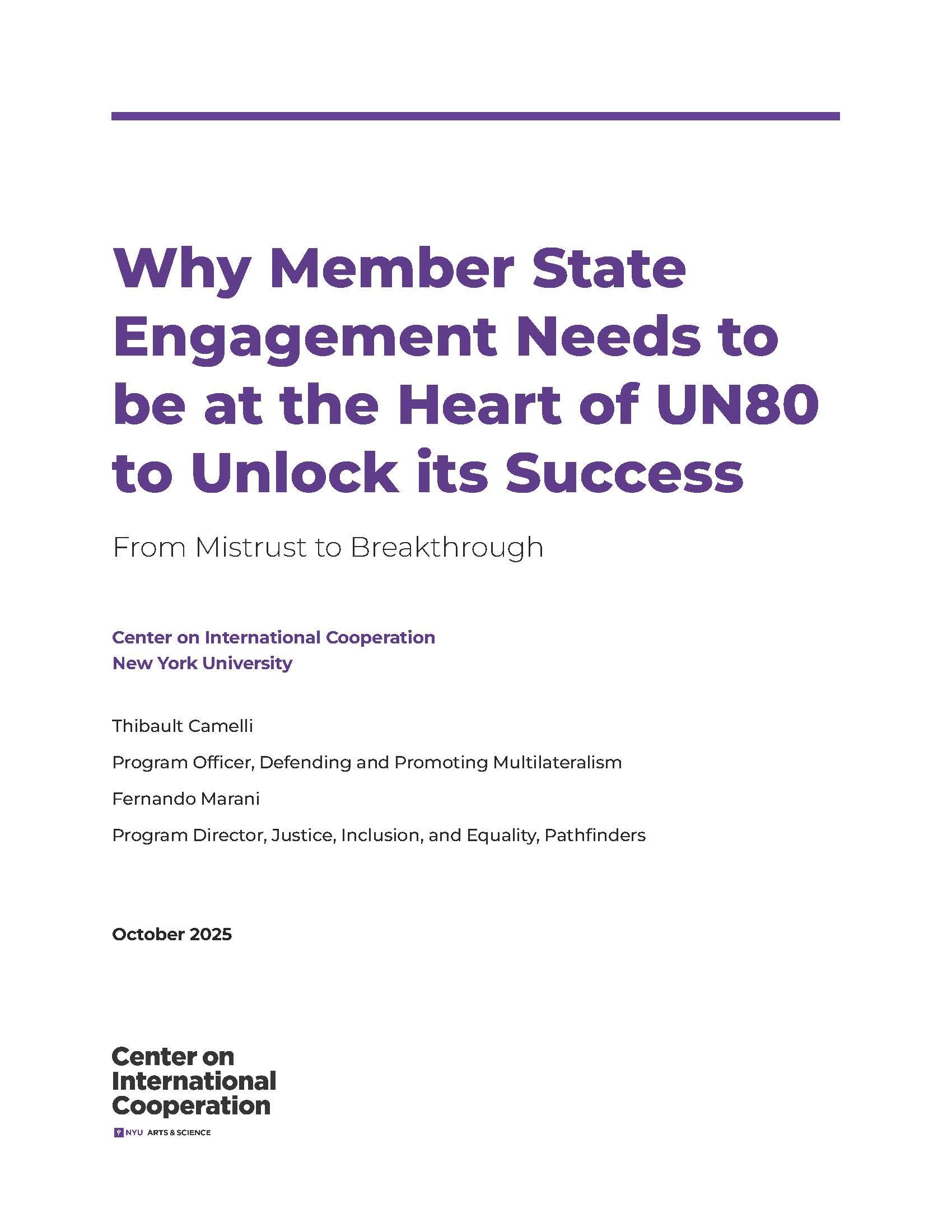
Why Member State Engagement Needs to be at the Heart of UN80 to Unlock its Success
This paper offers a practical toolkit of 10 recommendations for strengthening member state engagement in UN80.

A year after the Summit of the Future signaled the United Nations (UN) ambition to shape how the world manages artificial intelligence (AI) and emerging technologies through the Global Digital Compact (GDC), the organization now faces its own test. With the UN80 Initiative—the Secretary-General’s sweeping internal reform agenda—comes the chance to flip that outward pledge inward to better use AI. This is also an opportunity for the UN to become an active practitioner of emerging technologies, improving how the organization functions, from mandate rationalization to efficiency savings.
Yet, this moment is not only about efficiency. UN80 is also a test of whether the UN can embed innovation in its own machinery, despite political resistance stalling past reforms, from bureaucratic fragmentation and entrenched practices, to member state resistance. If UN80 manages to integrate AI in ways that are both effective and accountable, it could serve as a demonstration of how global norms could be operationalized in institutional transformation.
The Secretary-General’s initiative for major internal reform, launched on the occasion of the UN’s 80th anniversary, comes at a critical moment for the multilateral system. With international cooperation under strain and mounting financial pressures, Secretary-General António Guterres is making a final push at the end of his tenure to place the UN on a more sustainable path.
The reform process is organized around three workstreams. The first strand focuses on efficiency improvements and cost-cutting measures such as streamlining operations, reducing staff, and relocating offices. The second centers on mandate implementation, aiming to reduce duplication and align resources with priorities. The third explores broader structural reforms to make the UN fit for purpose in a new era.
If this reform effort succeeds, this process could help adapt the UN to a changing geopolitical environment. It could also provide the next Secretary-General, who will take office in January 2027, with a strengthened mandate and tailored tools to confront an increasingly complex set of global challenges. If the reform effort fails, whether due to obstruction or the UN’s inability to produce clear, concrete, and actionable measures to improve its structure and processes, the institution risks further erosion of credibility and trust as a body capable of confronting these challenges. Reform is rarely just a technical upgrade; it often becomes a struggle over authority and control, including concerns from member states that a more autonomous Secretariat could erode member-state control. Crucially, this moment is also about regaining trust in the multilateral system, which has declined over the past few years. According to the 2025 Edelman Trust Barometer, trust in the UN has eroded in 23 out of 27 surveyed countries between 2021 and 2024.
For UN80 to repair a fractured UN, the process needs to not only diagnose the institution’s ailments—some stemming from today’s shifting global landscape, others from outdated practices—but also prescribe and implement durable remedies for the long term. Crucially, this requires equipping the UN with the right tools for renewal. Emerging technologies, such as AI, big data, and blockchain, are rapidly becoming essential to how individuals, businesses, and governments operate. UN80 presents an opportunity to embed these tools within the organization itself, transforming them from external forces of change into instruments that enhance the UN’s effectiveness and efficiency.
If aligned with the principles of the UN Charter and the commitments outlined in the GDC, these technologies could also allow the UN to set an example for the world, showing how innovation can be integrated with accountability, political realism, and human-centered values.
If the UN is to remain relevant in a new era, it must embrace a technological dimension, and it has begun to take steps in that direction. Broadly, the UN’s AI work splits into two tracks: developing global norms and governance on one side, and hands-on capacity-building on the other.
Taking stock of the UN’s AI ecosystem reveals that, much like the broader organizational challenges that the UN80 reform effort is seeking to address, it is fragmented and complex. This does not mean it is destined to be inefficient, but it does suggest a risk of emerging systemic problems, which will become crucial to prevent in designing AI’s integration into a transformed UN.
On the normative side, several initiatives have recently emerged to bring greater coherence and systemization to the UN’s work on AI. The first normative milestone occurred in 2021, when UNESCO developed the first global standards on ethics in AI through its adoption of the Recommendation on the Ethics of AI. However, the most comprehensive UN-wide framework on AI governance to date was the adoption of the GDC in 2024, as an annex to the Pact of the Future. Comprising 70 commitments and principles, the GDC positioned the UN at the center of the AI global governance ecosystem and established a framework for addressing both the harmful consequences and leveraging its advantages to achieve the Sustainable Development Goals (SDGs).
The GDC did not emerge in isolation but was created through a series of building blocks, including initiatives by the Secretary-General and several General Assembly resolutions that began to shape the UN’s role in AI.
Other agencies and funds have also been involved in providing normative guidance on AI. These include the International Telecommunications Union (ITU), which hosts the annual World Summit on the Information Society, as well as the UN Development Programme’s (UNDP) AI Readiness program, which supports national governments in adopting AI responsibility.
On the operational side, the UN is only beginning to move towards a unified approach to AI. The creation of the Office of Digital and Emerging Technologies (ODET) in January 2025, tasked with overseeing the implementation of the GDC and enhancing system-wide coordination, represents a significant first step. For now, AI capacity-building and deployment mostly remain dispersed across specialized agencies, funds, and programs. Examples include the following initiatives:
Meanwhile, the UN High Commissioner for Refugees (UNHCR) and World Food Programme (WFP) have piloted AI-enabled early warning systems and anomaly detection in cash transfer operations. These pilots have demonstrated how AI can contribute to meaningful progress, but do not represent a cohesive adoption of the technology across the UN system.
As the UN80 process unfolds, signals are already emerging from both the Secretariat and member states indicating an appetite to integrate AI into the system. At the launch of UN80 in March 2025, Secretary-General Guterres described its aim as to “update the UN’s structures, priorities, and operations for the 21st century,” and has since noted plans to “expand automation and digital platforms.” Member states have also begun raising the prospect of more systematic AI use during consultations. Yet no formal mechanism exists to consider or advance proposals, leaving discussions scattered and ad hoc.
To address this gap, the UN needs to strike a balance between expert inputs and member states’ involvement. A practical way to achieve this balance would be to draw on the dual-track model created for global AI governance: a system-wide expert working group to identify entry points across the three UN80 workstreams (like the ISP-AI), paired with a structured dialogue to give member states a voice in shaping adoption (like the Dialogue on AI governance).
A mechanism to manage political sensitivities will be a necessity if AI is to be embedded into system-wide reform rather than left to scattered agency implementation. The UN must contend with a unique political environment, where member states scrutinize every Secretariat initiative and balance its innovation with their control. Concerns over bias, exclusion, and opacity could undermine trust if AI systems are deployed without transparency or oversight. The question of accountability for errors, whether in mandate drafting, resource allocation, or early warning, is also important to address. At the geopolitical level, the concentration of AI development in a handful of countries and companies raises the risk that global governance becomes dependent on external actors rather than rooted in multilateral legitimacy.
Addressing these sensitivities through a dedicated mechanism would not only safeguard legitimacy but could also unlock AI’s potential across UN80’s three workstreams. AI has clear applications in each.
At its core, UN80 faces a real test: will AI be harnessed as a driver of substantive institutional change, or will it be reduced to a symbolic echo of past reform cycles without actually shifting how the UN operates?
As the UN80 process continues to unfold, this is a crucial moment for stakeholders, including member states, civil society, and UN staff, to provide concrete inputs on how the Task Force should build on existing mechanisms and AI-based organizational design tools, with the aim of moving beyond scattered AI pilots into a system-wide resource that advances its workstreams with clear governance and accountability structures. Ultimately, legitimacy and trust in the UN will hinge less on the novelty of the tools it adopts than on whether AI is used to make governance more inclusive, accountable, and fair.
The political challenge, however, is unavoidable. AI thus becomes a test not of technology, but of politics: whether the UN can embed innovation despite entrenched habits and power constraints. Meeting this test will require a shared purpose and trust, anchoring innovation in the values that underpin the UN’s commitment to collective progress.

This paper offers a practical toolkit of 10 recommendations for strengthening member state engagement in UN80.

When designing new frameworks to regulate emerging technology, policymakers must use an approach that mitigates power imbalances at the individual and institutional levels.
Subscribe to our newsletter and receive regular updates on our latest events, analysis, and resources.
"*" indicates required fields